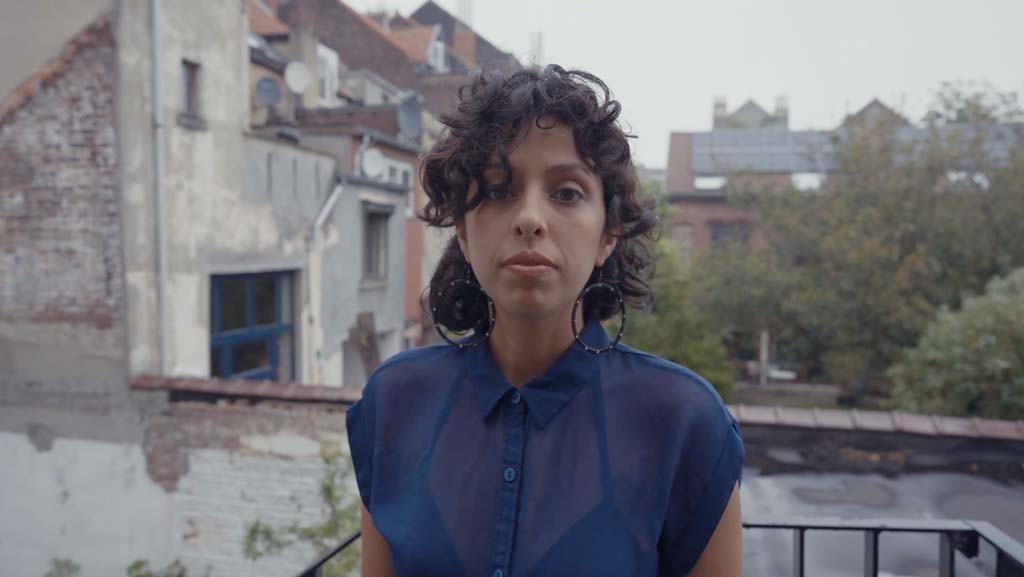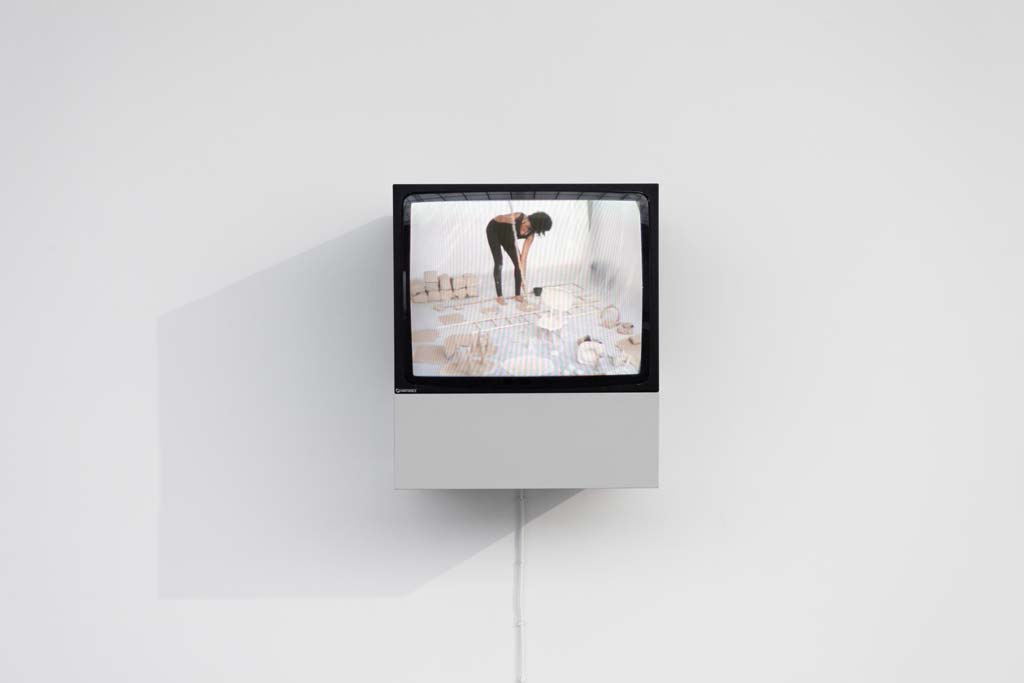FROM THERE, TO HERE AND ELSEWHERE
by Angyvir Padilla
Click on the image to open the gallery
Angyvir Padilla (Caracas, 1987) lives and works in Brussels. In her practice, she invites us to take a closer look at the places we inhabit. By examining how we embody memory, she proposes that, in the journey between immanence and transcendence, the traces of our past seep into a persistent present. The environments Angyvir creates alter our perception of reality. As our presence enters the dialogue, the sense of otherness we encounter reveals the essence of her work.
A chequerboard of wax tiles purposefully mislaid on sand, covers the floor, making transit a perilous endeavor. The promises and expectations of the civilization we know are violently disrupted by this subtle material intervention. The television screen on the other side of the tiles is the lure that urges us to cross this precarious pattern. The elixir must be inside the screen. Within, two voices silently echo in an exchange of subtitles, revealing a dialogue about ghosts. Angyvir is not afraid of ghosts; she misses them. Particularly those who are unable to cross the ocean, but whose howling can be clearly heard from the other side. She is not concerned with grandiloquent ghosts, but rather with the discreet, timid, hesitant ones. Ghosts who want to leave the country and cannot. Angyvir’s nostalgia is especially domestic as if the only house she knows are those of the past or as if, who knows how long ago, she lived in the open, destitute, as an orphan.
Click to zoom in
Angyvir explores a territory that she discovers with her body, thus making it her own. She moves tentatively towards its heart, a space that is intangible and uninhabited, defining it with her hands and with the only material she can interact with: blocks of clay. This place that seemed saturated with absence comes to life in the dialogue between the material and her body, allowing those objects that represent an idea of home to flourish. There are infinite possibilities to the substance of the clay when in contact with the body’s heat. Angyvir’s footsteps and her handling of the material reveals the impermanence of its form and allows the objects to take on their own life. They evolve in their form and function until finally, exhausted, they return to their origin, which is Angyvir, her body, her essence.
Here hopscotch is called the ‘little airplane’. In Caracas, as far as I can remember, the mystical or vertical variant of the game, which has the sky as its goal, is never played. Those of us who experienced Julio Cortazar’s Hopscotch, adopted the word to designate the game as well as the poetic and cosmogonic vision that pursues an ever-elusive sky. The Tandil Stone, nowadays replaced by a replica, originally stood in a precarious balancing act until 1912 in the Argentinean town of the same name. This 300-ton rock became a natural installation thanks to a “divine intervention”, descending in two moves, from the collapse that created it to the crash that finally destroyed it. It bridged the gap between heaven and earth, allowing the human and the divine to recognize each other through their instinct of play. With her performance, Angyvir conceives an unusual atmosphere in which floor bound elements are lifted from the ground. She delves into each of the ‘planes’, jumping from one side to the other, getting lost in her psyche, letting herself be carried away by the inevitable displacement provoked by the game and engaging with her own estrangement. In this way, there is a rupture with the linearity of the journey; she goes from there, to here and elsewhere.
—Essay written in the framework of Friends of S.M.A.K. Prize, 2021 by Mónica Echegarreta and Pedro Marrero.

-
Angyvir Padilla lives and works in Brussels. In her practice, she invites us to take a closer look at the places we inhabit. By examining how we embody memory, she proposes that, in the journey between immanence and transcendence, the traces of our past seep into a persistent present. The environments Angyvir creates alter our perception of reality. As our presence enters into the dialogue, the sense of otherness we encounter reveals the essence of her work. Master with distinction, Fine Arts department, Luca School of Arts, Brussels (BE), 2018, Master with distinction, Sculpture department, ENSAV La Cambre, Brussels (BE), 2015, Bachelor, Art in the public space, ARBA, Brussels (BE), 2012, among other distinctions. Read more: https://angyvir.com/.
-
Website: https://angyvir.com/
- Instagram: https://www.instagram.com/angyvirpadilla/
ROOM is entirely dependent upon reader support. Please consider helping ROOM today with a tax-deductible donation. Any amount is deeply appreciated. |












![Genesis, 2024 [Detail]](https://analytic-room.com/wp-content/uploads/2025/07/HQ27-TL20896S_Tau_Lewis__title_TBC__small_figure___2024_6_high_quality-110x80.jpg)